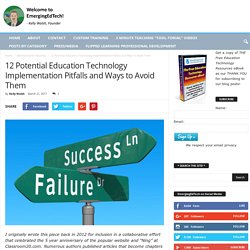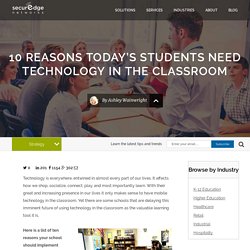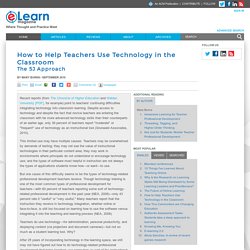

12 Potential Education Technology Implementation Pitfalls and Ways to Avoid Them. I originally wrote this piece back in 2012 for inclusion in a collaborative effort that celebrated the 5 year anniversary of the popular website and “Ning” at Classroom20.com.

Numerous authors published articles that become chapters in a book that was ultimately published in the form of a digital collection on Scribd. I’ve been thinking for years about updating this and republishing it here to share with EmergingEdTech readers. This is a great piece for technology staff and managers alike to review, and it is informed by decades of experience. Also, note that this type of “checklist” can be helpful for quick reviews of smaller scale efforts just as it applies to larger projects.
I hope you find it useful and informative. – K. After several decades of managing technology projects, I have enjoyed a good number of successes, but have also had the good fortune of being involved in some failures. No 1: Insufficient Budget 2. 3. Sponsors should be involved at key points in your project. 4. Not Enough Time: Teachers Struggle With Technology Due to Lack Of Training – Inklings / The news site of Staples High School. There are iPads in the library, SMART Boards in classrooms, and a Staples iPhone app so students can record homework and follow their daily schedules.

But what happens on any given day can be a different story. Researching instructional use and the technology acceptation of learning management systems by secondary school teachers. Abstract The aim of this large-scale study was to understand the technology acceptation of learning management systems (LMS) by secondary school teachers and to investigate the instructional use of LMS, distinguishing between informational use and communicational use.

The predictive model further includes: perceived usefulness, perceived ease of use, subjective norm, personal innovativeness in the domain of information technology, experience and internal ICT support at school level. Data were collected from 505 Flemish secondary school teachers. After performing satisfactory reliability and validity checks, the study was able to support all relationships among the 9 variables. Informational use was found to be a precursor for communicational use, perceived ease of use of the LMS is the strongest predictor in LMS-acceptation.
Highlights Keywords. EJ1084227. 10 ways to change the minds of tech-reluctant staff. Getting Faculty Buy In LMS. Your First Steps in Creating Tech-Savvy Teachers - Chalk Talk. Whether you’re an administrator looking to add more technology to your organization, or a teacher leading the tech charge in your school, helping other teachers get up to speed can be difficult.

It’s even more difficult during the back to school season, with increased teacher stress levels and young teachers starting their first years of instruction. It is important to remember that technology is a tool, not a subject. The P21 framework (Partnership for 21st Century Learning) indicates “information, media, and technology skills” as only 1 of the 4 areas of 21st-century skills. Encouraging the use of technology by your teachers should be focused both on classroom instruction, and improving their daily workflow. One of the most significant daily workflow improvements comes from data backed decision making.
Data and analytics Many people incorrectly assume that saving time is the greatest value that they can gain from technology. Overcoming the fear of failure. How to Get Hesitant Teachers to Use Technology. In my consulting as well as administrative technology work, I am often asked the same questions by different schools and officials.

One of the most common is: “How do you get teachers who are hesitant or resistant to use technology?” I am keenly aware that many of my colleagues are not, for various reasons, gung ho about educational technology. And it’s interesting. Quite often, the teachers who are hesitant to adopt new technology are great — in fact, amazing — educators. They are frequently veterans and usually leaders in their academic field and within their institutions. In my role as tech advocate, I habitually find myself trying to coax these established educators to use new tools and incorporate new methodologies. 1. If you’re working with veteran educators, this is especially important. Instead, try this: observe what they do in the classroom that’s made them successful and build out from there. 2. 3.
Encouraging Teacher Technology Use. Technology use in classroom instruction can vary greatly from school to school.

We asked the Education World Tech Team how their schools encourage -- or discourage -- staff technology use. Helping Teachers Who Struggle with Technology. The Administrator's Role in Technology Integration. 10 Reasons Today’s Students NEED Technology in the Classroom. Technology is everywhere, entwined in almost every part of our lives.

It affects how we shop, socialize, connect, play, and most importantly learn. 5 Tips to Help Teachers Who Struggle with Technology. "I'm not very tech savvy" is the response I usually hear from teachers that struggle with technology.

Whether it's attaching a document to an email or creating a PowerPoint, some teachers really have a difficult time navigating the digital world. As schools around the globe begin to embed the use of technology in their learning environments, these teachers can be left feeling frustrated and marginalized by the new tools they are required to use but do not understand. The school where I teach is currently within its post-BYOD (Bring Your Own Device) implementation age. We started with a small cohort of tech-savvy teachers to pilot a BYOD program with selected classes. Starting small was definitely beneficial, as we were able to troubleshoot issues and best prepare ourselves for the school-wide BYOD rollout. 1. Integrating technology can be very stressful for educators that aren't familiar with it. 2. 3. How to Help Teachers Use Technology in the Classroom.
Recent reports (from The Chronicle of Higher Education and Walden University [PDF], for example) point to teachers' continuing difficulties integrating technology into classroom learning.

Despite access to technology and despite the fact that novice teachers are entering the classroom with far more advanced technology skills than their counterparts of an earlier age, only 39 percent of teachers report "moderate" or "frequent" use of technology as an instructional tool (Grunwald Associates, 2010). This limited use may have multiple causes: Teachers may be overwhelmed by demands of testing; they may not see the value of instructional technologies in their particular content area; they may work in environments where principals do not understand or encourage technology use; and the types of software most helpful in instruction are not always the types of applications students know how—or want—to use.
Back to the Drawing Board: The 5Js Beyond Skills Training: A Theory of Action Job-Related.